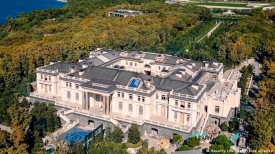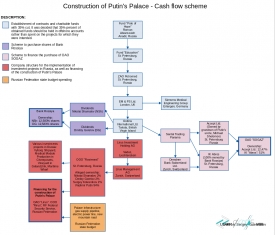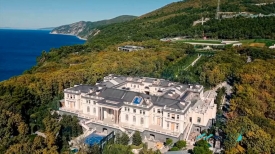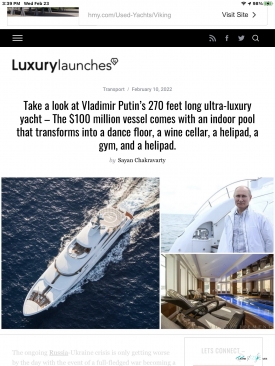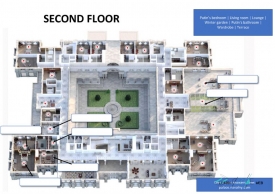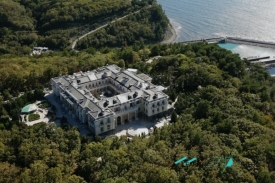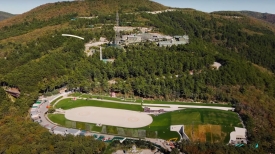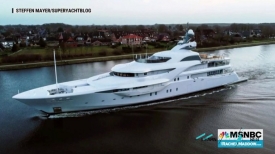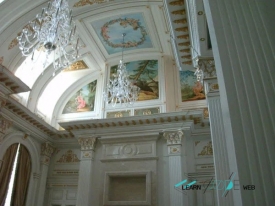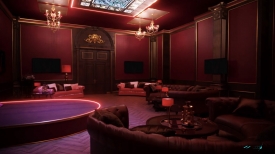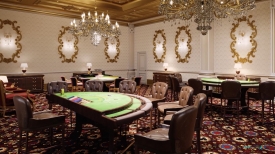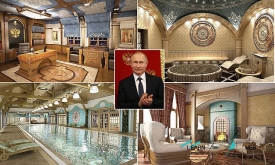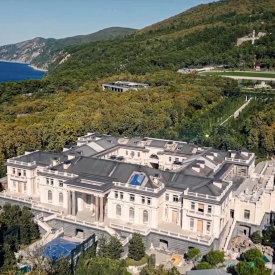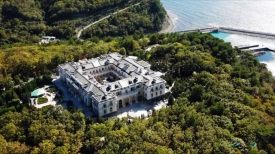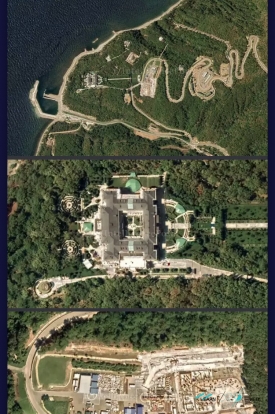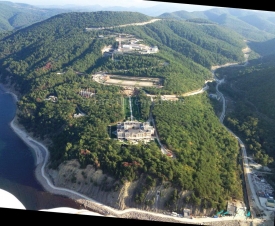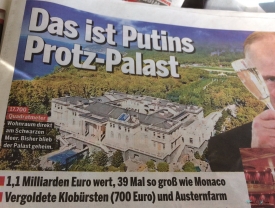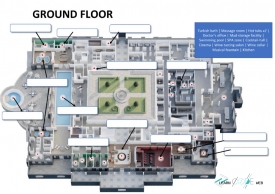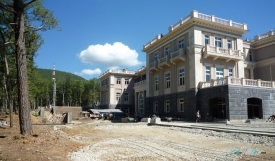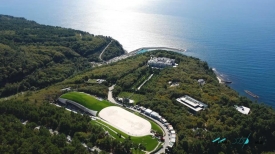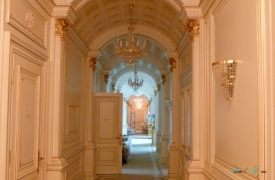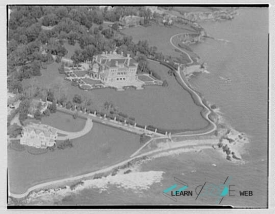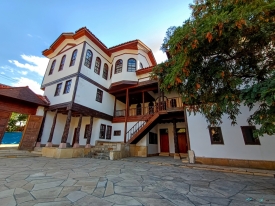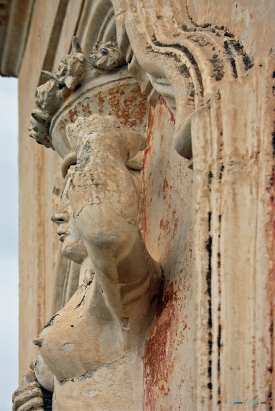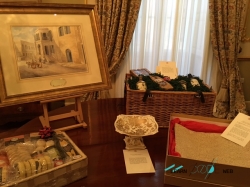ABOUT Palace of Putin in the Black Sea
The residence is located on Cape Idokopas, near the village of Praskoveyevka. Cape Idokopas (Russian: Мыс Идокопас) is a headland on the Russian Black Sea coast near Gelendzhik, Krasnodar Krai. The promontory is lined with cliffs, but its summit is mostly flat, which is densely covered with Turkish pine forests. It is bordered by a reef that makes navigation on the high seas dangerous. The residence overlooks Russia's Black Sea coast and is built on a block of land with a total area of 74 hectares. The airspace around the palace (see image) is regulated as Special Use Prohibited Airspace P116 (i.e. a no-fly zone), so the Russian Federal Security Service (FSB) declared it to be to protect a post FSB border patrol in the area of increased foreign intelligence activity.
The BBC Russian section interviewed a laborer who worked on the construction of the palace, Stanislav (not his real name) said he had come to work at the construction site in the Black Sea resort of Gelendzhik in autumn 2018. The palace had many remnants of the lavish decoration shown in Navalny's film, but most of the furniture was gone. "The scale [of the opulence] had been incredible. Later, much of the palace was dismantled," he told BBC Russian.
The mold problem was mentioned in the video and Navalny claimed that the palace was under reconstruction because of it. Two builders say they saw the mold themselves.
"The walls and ceilings were covered in mould. Just ordinary, green mould. In some places even black. It affected the whole building. We were shocked," Stanislav told the BBC. The palace was built with plasterboard attached to the main walls and the mold appeared between the concrete walls and the plasterboard.
A source close to the Kremlin confirmed to the Russian BBC that the mold was a real problem: "The palace had been finished and was used for several years, but then the fungus appeared, accompanied by an unpleasant smell."
Visiting the property in the fall of 2011, a builder the BBC spoke to said his first impression of it was that it was as if the pyramids of Egypt were being built.
"I estimate that about 1,500 people were working on the construction site at the time. There were Russians, Uzbeks, there were soldiers. There was a rush to finish it."
Another worker said all the construction signs were camouflaged so they couldn't be seen from the sea. "All the concrete and metal structures had hills, trees, grass and rocks painted on them to cover them up, so they blend in with the landscape."
Many of the workers who told the BBC they had worked on the site in the last 15 years speak of frequent rebuilding. "They kept building and tearing down, building and then tearing down," said one builder.
Speculation abounds as to how the former KGB agent managed to acquire such a large fortune. A Forbes investigation turned up suggestions ranging from theft and extortion to bribery and funneling state funds into their private coffers (or a combination of all of the above). Reports about Putin's lavish lifestyle, completely at odds with his official salary that the Kremlin reveals every year, have been coming out of Russia for years.
In a letter to Dmitry Medvedev and later in an interview with RTVI and other media outlets, Sergey Kolesnikov revealed a plan to finance the construction of the residence. According to Kolesnikov, in 1992, with the participation of Putin, the Petromed company was created, which was engaged in projects in the field of medical care. After Putin became president, his friend the businessman Nikolai Shamalov joined the company (together with Putin, he co-founded the Ozero dacha cooperative. In 2005, on behalf of Shamalov, Kolesnikov created the Rosinvest company, the structure of which ownership was hidden behind anonymous "bearer shares", but most of the shares were managed in the interests of Putin. One of Rosinvest's projects, which Shamalov personally supervised, was the construction of "Putin's Palace". documents, it was indicated that Shamalov was the owner of the palace under construction, and of the high-ranking officials, only the name of Vladimir Kozhin, who at that time held the post of head of the Presidential Administration, appeared. from the palace, and this project was combined with an elite vineyard and wine production project in 2007. The combined project was named "Project South". Kolesnikov claimed that after he beginning of the 2008 financial crisis, Putin ordered Shamalov to suspend all other projects and focus on e
The BBC Russian section interviewed a laborer who worked on the construction of the palace, Stanislav (not his real name) said he had come to work at the construction site in the Black Sea resort of Gelendzhik in autumn 2018. The palace had many remnants of the lavish decoration shown in Navalny's film, but most of the furniture was gone. "The scale [of the opulence] had been incredible. Later, much of the palace was dismantled," he told BBC Russian.
The mold problem was mentioned in the video and Navalny claimed that the palace was under reconstruction because of it. Two builders say they saw the mold themselves.
"The walls and ceilings were covered in mould. Just ordinary, green mould. In some places even black. It affected the whole building. We were shocked," Stanislav told the BBC. The palace was built with plasterboard attached to the main walls and the mold appeared between the concrete walls and the plasterboard.
A source close to the Kremlin confirmed to the Russian BBC that the mold was a real problem: "The palace had been finished and was used for several years, but then the fungus appeared, accompanied by an unpleasant smell."
Visiting the property in the fall of 2011, a builder the BBC spoke to said his first impression of it was that it was as if the pyramids of Egypt were being built.
"I estimate that about 1,500 people were working on the construction site at the time. There were Russians, Uzbeks, there were soldiers. There was a rush to finish it."
Another worker said all the construction signs were camouflaged so they couldn't be seen from the sea. "All the concrete and metal structures had hills, trees, grass and rocks painted on them to cover them up, so they blend in with the landscape."
Many of the workers who told the BBC they had worked on the site in the last 15 years speak of frequent rebuilding. "They kept building and tearing down, building and then tearing down," said one builder.
Speculation abounds as to how the former KGB agent managed to acquire such a large fortune. A Forbes investigation turned up suggestions ranging from theft and extortion to bribery and funneling state funds into their private coffers (or a combination of all of the above). Reports about Putin's lavish lifestyle, completely at odds with his official salary that the Kremlin reveals every year, have been coming out of Russia for years.
In a letter to Dmitry Medvedev and later in an interview with RTVI and other media outlets, Sergey Kolesnikov revealed a plan to finance the construction of the residence. According to Kolesnikov, in 1992, with the participation of Putin, the Petromed company was created, which was engaged in projects in the field of medical care. After Putin became president, his friend the businessman Nikolai Shamalov joined the company (together with Putin, he co-founded the Ozero dacha cooperative. In 2005, on behalf of Shamalov, Kolesnikov created the Rosinvest company, the structure of which ownership was hidden behind anonymous "bearer shares", but most of the shares were managed in the interests of Putin. One of Rosinvest's projects, which Shamalov personally supervised, was the construction of "Putin's Palace". documents, it was indicated that Shamalov was the owner of the palace under construction, and of the high-ranking officials, only the name of Vladimir Kozhin, who at that time held the post of head of the Presidential Administration, appeared. from the palace, and this project was combined with an elite vineyard and wine production project in 2007. The combined project was named "Project South". Kolesnikov claimed that after he beginning of the 2008 financial crisis, Putin ordered Shamalov to suspend all other projects and focus on e
The Best Pictures of Palace of Putin in the Black Sea
Videos of Palace of Putin in the Black Sea



















